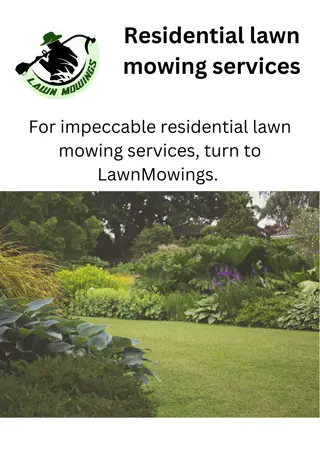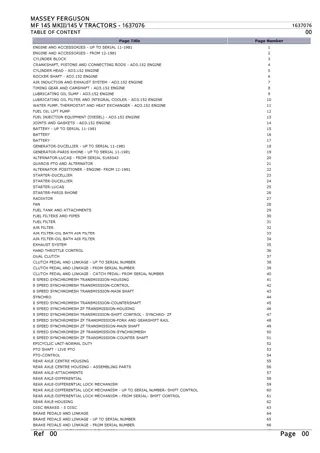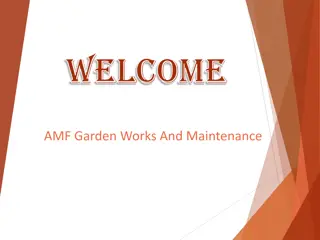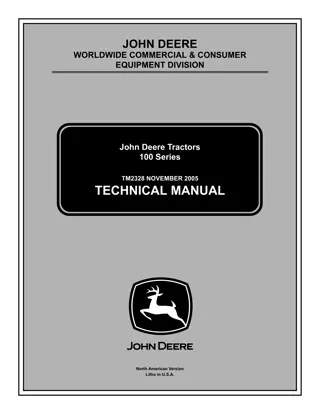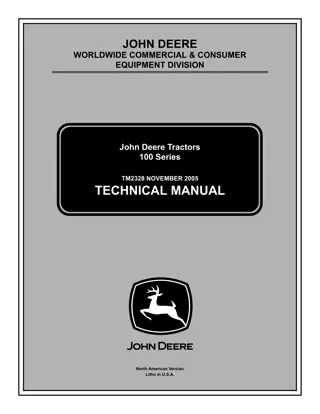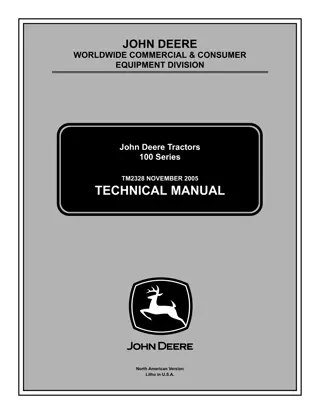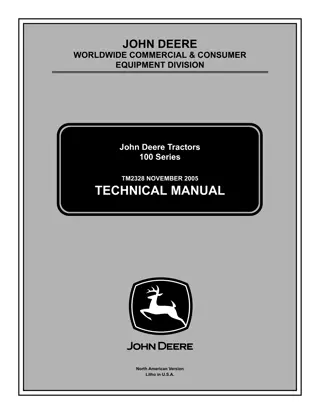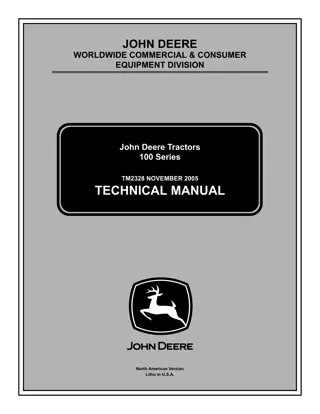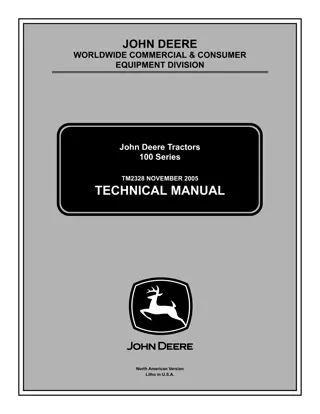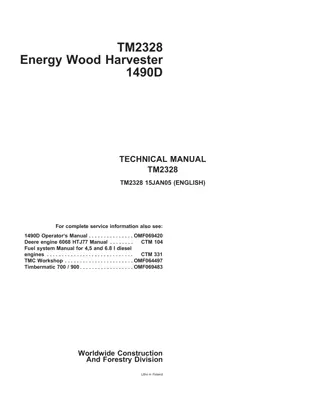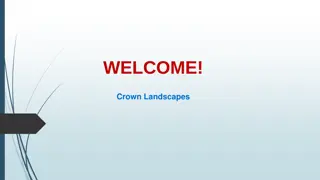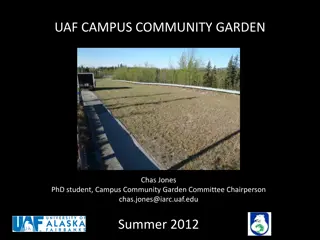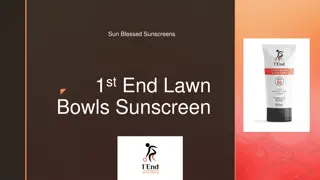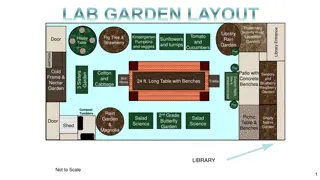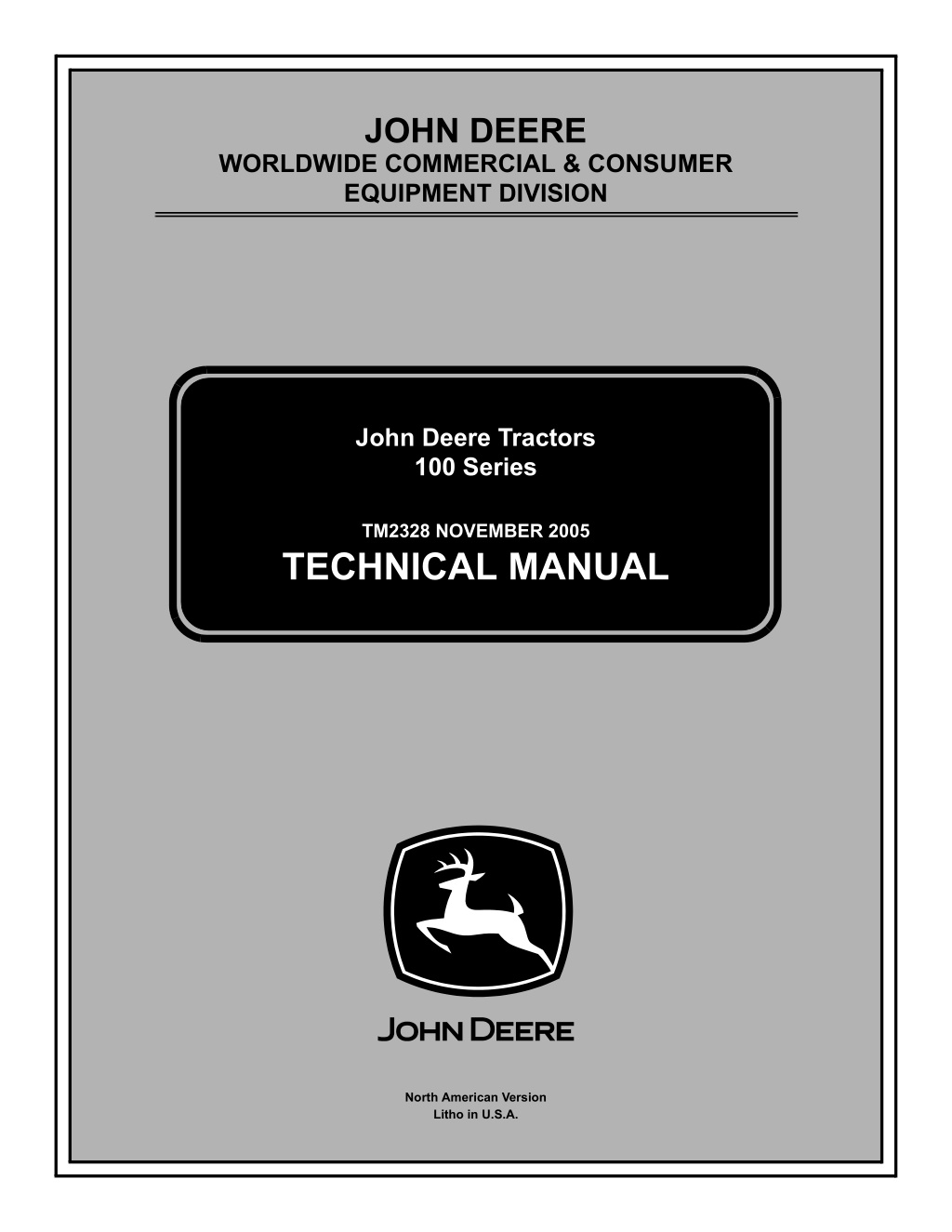
JOHN DEERE 145 LAWN GARDEN TRACTOR Service Repair Manual Instant Download (TM2328)
Please open the website below to get the complete manualnn// n
Download Presentation

Please find below an Image/Link to download the presentation.
The content on the website is provided AS IS for your information and personal use only. It may not be sold, licensed, or shared on other websites without obtaining consent from the author. Download presentation by click this link. If you encounter any issues during the download, it is possible that the publisher has removed the file from their server.
E N D
Presentation Transcript
JOHN DEERE WORLDWIDE COMMERCIAL & CONSUMER EQUIPMENT DIVISION 2328 November 2005 John Deere Tractors 100 Series TM2328 NOVEMBER 2005 TECHNICAL MANUAL North American Version Litho in U.S.A.
INTRODUCTION Manual Description Introduction Safety This technical manual is written for an experienced technician and contains sections that are specifically for this product. It is a part of a total product support program. Specifications and Information The manual is organized so that all the information on a particular system is kept together. The order of grouping is as follows: Engine (B&S - Single Cylinder) Table of Contents Specifications and Information Identification Numbers Engine (B&S - V-Twin) Tools and Materials Component Location Schematics and Harnesses Electrical Theory of Operation Operation and Diagnostics Power Train (Gear) Diagnostics Tests and Adjustments Repair Power Train (Hydrostatic) Other NOTE: Depending on the particular section or system being covered, not all of the above groups may be used. Steering The bleed tabs for the pages of each section will align with the sections listed on this page. Page numbering is consecutive from the beginning of the Safety section through the last section. Brakes We appreciate your input on this manual. If you find any errors or want to comment on the layout of the manual please contact us. Attachments Miscellaneous
SAFETY Replace Safety Signs Safety Recognize Safety Information MIF Replace missing or damaged safety signs. See the machine operator s manual for correct safety sign placement. MIF This is the safety-alert symbol. When you see this symbol on your machine or in this manual, be alert to the potential for personal injury. Understand Signal Words A signal word - DANGER, WARNING, or CAUTION - is used with the safety-alert symbol. DANGER identifies the most serious hazards. Follow recommended precautions and safe servicing practices. DANGER or WARNING safety signs are located near specific hazards. General precautions are listed on CAUTION safety signs. CAUTION also calls attention to safety messages in this manual. Special Messages Your manual contains special messages to bring attention to potential safety concerns, machine damage as well as helpful operating and servicing information. Please read all the information carefully to avoid injury and machine damage. c CAUTION: Avoid injury! This symbol and text highlight potential hazards or death to the operator or bystanders that may occur if the hazards or procedures are ignored. Handle Fluids Safely - Avoid Fires Be Prepared For Emergencies IMPORTANT: Avoid damage! This text is used to tell the operator of actions or conditions that might result in damage to the machine. MIF heaters or other fire hazards. When you work around fuel, do not smoke or work near NOTE: General information is given throughout the manual that may help the operator in the operation or service of the machine. incinerate or puncture pressurized containers. Store flammable fluids away from fire hazards. Do not debris. Make sure machine is clean of trash, grease, and spontaneously. Do not store oily rags; they can ignite and burn Be prepared if a fire starts. Keep a first aid kit and fire extinguisher handy. service, hospital, and fire department near your telephone. Keep emergency numbers for doctors, ambulance Safety - 1
https://www.ebooklibonline.com Hello dear friend! Thank you very much for reading. Enter the link into your browser. The full manual is available for immediate download. https://www.ebooklibonline.com
SAFETY Use Care In Handling and Servicing Batteries Wear Protective Clothing MIF Wear close fitting clothing and safety equipment appropriate to the job. MIF Prolonged exposure to loud noise can cause impairment or loss of hearing. Wear a suitable hearing protective device such as earmuffs or earplugs to protect against objectionable or uncomfortable loud noises. Prevent Battery Explosions from the top of battery. Battery gas can explode. Keep sparks, lighted matches, and open flame away across the posts. Use a volt-meter or hydrometer. Never check battery charge by placing a metal object Operating equipment safely requires the full attention of the operator. Do not wear radio or music headphones while operating machine. battery to 16 C (60 F). Do not charge a frozen battery; it may explode. Warm Parking Safely Prevent Acid Burns 1. Stop machine on a level surface, not on a slope. strong enough to burn skin, eat holes in clothing, and cause blindness if splashed into eyes. Sulfuric acid in battery electrolyte is poisonous. It is 2. Disengage PTO and stop attachments. 3. Lower attachments to the ground. 4. Lock park brake. Avoid acid burns by: 5. Stop engine. 1. Filling batteries in a well-ventilated area. 6. Remove key. 2. Wearing eye protection and rubber gloves. 7. Wait for engine and all moving parts to stop before you leave the operator s station. 3. Avoiding breathing fumes when electrolyte is added. 4. Avoiding spilling or dripping electrolyte. 8. Close fuel shut-off valve, if your machine is equipped. 5. Use proper jump start procedure. Service Machines Safely If you spill acid on yourself: 1. Flush your skin with water. 2. Apply baking soda or lime to help neutralize the acid. 3. Flush your eyes with water for 10 - 15 minutes. 4. Get medical attention immediately. If acid is swallowed: 1. Drink large amounts of water or milk. MIF 2. Then drink milk of magnesia, beaten eggs, or vegetable oil. Tie long hair behind your head. Do not wear a necktie, scarf, loose clothing, or necklace when you work near machine tools or moving parts. If these items were to get caught, severe injury could result. 3. Get medical attention immediately. Remove rings and other jewelry to prevent electrical shorts and entanglement in moving parts. Safety - 2
SAFETY Use Proper Tools Illuminate Work Area Safely Use tools appropriate to the work. Makeshift tools and procedures can create safety hazards. Use power tools only to loosen threaded parts and fasteners. For loosening and tightening hardware, use the correct size tools. DO NOT use U.S. measurement tools on metric fasteners. Avoid bodily injury caused by slipping wrenches. Use only service parts meeting John Deere specifications. Illuminate your work area adequately but safely. Use a portable safety light for working inside or under the machine. Make sure the bulb is enclosed by a wire cage. The hot filament of an accidentally broken bulb can ignite spilled fuel or oil. Work In Ventilated Area Work in Clean Area Before starting a job: 1. Clean work area and machine. 2. Make sure you have all necessary tools to do your job. 3. Have the right parts on hand. 4. Read all instructions thoroughly; do not attempt shortcuts. MIF Support Machine Properly and Use Proper Lifting Equipment Engine exhaust fumes can cause sickness or death. If it is necessary to run an engine in an enclosed area, remove the exhaust fumes from the area with an exhaust pipe extension. If you do not have an exhaust pipe extension, open the doors and get outside air into the area. Warning: California Proposition 65 Warning Gasoline engine exhaust from this product contains chemicals known to the State of California to cause cancer, birth defects, or other reproductive harm. Diesel engine exhaust and some of its constituents are known to the State of California to cause cancer, birth defects, and other reproductive harm. MIF If you must work on a lifted machine or attachment, securely support the machine or attachment. Remove Paint Before Welding or Heating Do not support the machine on cinder blocks, hollow tiles, or props that may crumble under continuous load. Do not work under a machine that is supported solely by a jack. Follow recommended procedures in this manual. Avoid potentially toxic fumes and dust. Hazardous fumes can be generated when paint is heated by welding, soldering, or using a torch. Do all work outside or in a well ventilated area. Dispose of paint and solvent properly. Remove paint before welding or heating: If you sand or grind paint, avoid breathing the dust. Wear an approved respirator. If you use solvent or paint stripper, remove stripper with soap and water before welding. Remove solvent or paint stripper containers and other flammable material from area. Allow fumes to disperse at least 15 minutes before welding or heating. Lifting heavy components incorrectly can cause severe injury or machine damage. Follow recommended procedure for removal and installation of components in the manual. Using High Pressure Washers Directing pressurized water at electronic/electrical components or connectors, bearings, hydraulic seals, fuel injection pumps or other sensitive parts and components may cause product malfunctions. Reduce pressure and spray at a 45 to 90 degree angle. Safety - 3
SAFETY Avoid Harmful Asbestos Dust Avoid Injury From Rotating Blades and Augers Avoid breathing dust that may be generated when handling components containing asbestos fibers. Inhaled asbestos fibers may cause lung cancer. Components in products that may contain asbestos fibers are brake pads, brake band and lining assemblies, clutch plates, and some gaskets. The asbestos used in these components is usually found in a resin or sealed in some way. Normal handling is not hazardous as long as airborne dust containing asbestos is not generated. MIF Avoid creating dust. Never use compressed air for cleaning. Avoid brushing or grinding material containing asbestos. When servicing, wear an approved respirator. A special vacuum cleaner is recommended to clean asbestos. If not available, apply a mist of oil or water on the material containing asbestos. Keep bystanders away from the area. Keep hands and feet away while machine is running. Shut off power to service, lubricate or remove mower blades, augers or PTO shafts. Handle Chemical Products Safely Service Tires Safely MIF Direct exposure to hazardous chemicals can cause serious injury. Potentially hazardous chemicals used with John Deere equipment include such items as lubricants, coolants, paints, and adhesives. MIF A Material Safety Data Sheet (MSDS) provides specific details on chemical products: physical and health hazards, safety procedures, and emergency response techniques. Check the MSDS before you start any job using a hazardous chemical. That way you will know exactly what the risks are and how to do the job safely. Then follow procedures and recommended equipment. Explosive separation of a tire and rim parts can cause serious injury or death. Do not attempt to mount a tire unless you have the proper equipment and experience to perform the job. Always maintain the correct tire pressure. Do not inflate the tires above the recommended pressure. Never weld or heat a wheel and tire assembly. The heat can cause an increase in air pressure resulting in a tire explosion. Welding can structurally weaken or deform the wheel. When inflating tires, use a clip-on chuck and extension hose long enough to allow you to stand to one side and NOT in front of or over the tire assembly. Use a safety cage if available. Check wheels for low pressure, cuts, bubbles, damaged rims or missing lug bolts and nuts. Safety - 4
SAFETY Dispose of Waste Properly Improperly disposing of waste can threaten the environment and ecology. Potentially harmful waste used with John Deere equipment include such items as oil, fuel, coolant, brake fluid, filters, and batteries. Use leakproof containers when draining fluids. Do not use food or beverage containers that may mislead someone into drinking from them. Do not pour waste onto the ground, down a drain, or into any water source. Inquire on the proper way to recycle or dispose of waste from your local environmental or recycling center, or from your John Deere dealer. Live with Safety MIF Before returning machine to customer, make sure machine is functioning properly, especially the safety systems. Install all guards and shields. Safety - 5
SPECIFICATIONS & INFORMATION TABLE OF CONTENTS Specifications & Information Table of Contents Fastener Torques..............................................9 Metric Fastener Torque Values......................9 Metric Fastener Torque Value - Grade 7......10 Inch Fastener Torque Values.......................11 General Information........................................13 Gasoline.......................................................13 Gasoline Storage..........................................13 4 - Cycle Gasoline Engine Oil ......................14 Break-In Engine Oil - 4-Cycle Gasoline........14 Alternative Lubricants...................................14 Synthetic Lubricants.....................................14 Lubricant Storage.........................................15 Mixing Of Lubricants.....................................15 Grease..........................................................15 Chain Lubricant............................................15 Hydrostatic Transmission Oil........................15 Serial Number Locations ...............................16 Machine Product Identification Number .......16 Engine Serial Number..................................16 Transaxle Serial Number..............................16 Specifications & Information Table of Contents - 7
SPECIFICATIONS & INFORMATION FASTENER TORQUES Fastener Torques Metric Fastener Torque Values 12.9 4.8 8.8 9.8 10.9 Property Class and Head Markings 12.9 10.9 9.8 8.8 4.8 8.8 12.9 9.8 4.8 10.9 12.9 Property Class and Nut Markings 12 10 10 5 10 10 12 5 10 5 10 12 MIF Class 4.8 Class 8.8 or 9.8 Class 10.9 Class 12.9 Lubricated a Dry a Lubricated a Dry a Lubricated a Dry a Lubricated a Dry a SIZE N m lb-ft N m lb-ft N m lb-ft N m lb-ft N m lb-ft N m lb-ft N m lb-ft N m lb-ft M6 4.8 3.5 6 4.5 9 6.5 11 8.5 13 9.5 17 12 15 11.5 19 14.5 M8 12 8.5 15 11 22 16 28 20 32 24 40 30 37 28 47 35 M10 23 17 29 21 43 32 55 40 63 47 80 60 75 55 95 70 M12 40 29 50 37 75 55 95 70 110 80 140 105 130 95 165 120 M14 63 47 80 60 120 88 150 110 175 130 225 165 205 150 260 109 DO NOT use these hand torque values if a different torque value or tightening procedure is given for a specific application. Torque values listed are for general use only and include a 10% variance factor. Check tightness of fasteners periodically. DO NOT use air powered wrenches. When bolt and nut combination fasteners are used, torque values should be applied to the NUT instead of the bolt head. Tighten toothed or serrated-type lock nuts to the full torque value. Shear bolts are designed to fail under predetermined loads. Always replace shear bolts with identical grade. a Lubricated means coated with a lubricant such as engine oil, or fasteners with phosphate and oil coatings. Dry means plain or zinc plated (Yellow Dichromate - Specification JDS117) without any lubrication. Fasteners should be replaced with the same class. Make sure fastener threads are clean and that you properly start thread engagement. This will prevent them from failing when tightening. Reference: JDS - G200 Metric Fastener Torque Value - Grade 7 Size Steel or Gray Iron Torque Aluminum Torque Size Steel or Gray Iron Torque Aluminum Torque N m lb-ft N m lb-ft N m lb-ft N m lb-ft M12 88 65 70 52 M6 11 8 8 6 M14 138 102 111 82 M8 24 18 19 14 M10 52 38 41 30 Specifications & Information Fastener Torques - 9
SPECIFICATIONS & INFORMATION FASTENER TORQUES Inch Fastener Torque Values 8 5.2 5.1 5 8.2 1 or 2b SAE Grade and Head Markings No Marks 5 2 8 SAE Grade and Nut Markings No Marks MIF Grade 1 Grade 2b Grade 5, 5.1 or 5.2 Grade 8 or 8.2 Lubricated a Dry a Lubricated a Dry a Lubricated a Dry a Lubricated a Dry a SIZE N m lb-ft N m lb-ft N m lb-ft N m lb-ft N m lb-ft N m lb-ft N m lb-ft N m lb-ft 1/4 3.7 2.8 4.7 3.5 6 4.5 7.5 5.5 9.5 7 12 9 13.5 10 17 12.5 5/16 7.7 5.5 10 7 12 9 15 11 20 15 25 18 28 21 35 26 3/8 14 10 17 13 22 16 27 20 35 26 44 33 50 36 63 46 7/16 22 16 28 20 35 26 44 32 55 41 70 52 80 58 100 75 1/2 33 25 42 31 53 39 67 50 85 63 110 80 120 90 150 115 9/16 48 36 60 45 75 56 95 70 125 90 155 115 175 130 225 160 5/8 67 50 85 62 105 78 135 100 170 125 215 160 215 160 300 225 3/4 120 87 150 110 190 140 240 175 300 225 375 280 425 310 550 400 7/8 190 140 240 175 190 140 240 175 490 360 625 450 700 500 875 650 1 290 210 360 270 290 210 360 270 725 540 925 675 1050 750 1300 975 1-1/8 470 300 510 375 470 300 510 375 900 675 1150 850 1450 1075 1850 1350 value. DO NOT use these hand torque values if a different torque value or tightening procedure is given for a specific application. Torque values listed are for general use only and include a 10% variance factor. Check tightness of fasteners periodically. DO NOT use air powered wrenches. a Lubricated means coated with a lubricant such as engine oil, or fasteners with phosphate and oil coatings. Dry means plain or zinc plated (yellow dichromate - Specification JDS117) without any lubrication. Shear bolts are designed to fail under predetermined loads. Always replace shear bolts with identical grade. b Grade 2 applies for hex cap screws (Not Hex Bolts) up to 152 mm (6 in.) long. Grade 1 applies for hex cap screws over 152 mm (6 in.) long, and for all other types of bolts and screws of any length. Fasteners should be replaced with the same grade. Make sure fastener threads are clean and that you properly start thread engagement. This will prevent them from failing when tightening. Reference: JDS - G200 When bolt and nut combination fasteners are used, torque values should be applied to the NUT instead of the bolt head. Tighten toothed or serrated-type lock nuts to the full torque Specifications & Information Fastener Torques - 10
SPECIFICATIONS & INFORMATION GENERAL INFORMATION General Information Gasoline c CAUTION: Avoid injury! Gasoline is HIGHLY FLAMMABLE, handle it with care.DO NOT refuel machine while: indoors, always fill gas tank outdoors machine is near an open flame or sparks engine is running, STOP engine mif engine is hot, allow it to cool sufficiently first exceed 15% by volume methyl tertiary butyl ether (MTBE) blends DO NOT smoking Help prevent fires: IMPORTANT: Avoid damage! DO NOT use METHANOL gasolines because METHANOL is harmful to the environment and to your health. c CAUTION: Avoid injury! California Proposition 65 Warning: Gasoline engine exhaust from this product contains chemicals known to the State of California to cause cancer, birth defects, or other reproductive harm. fill gas tank to bottom of filler neck only be sure fill cap is tight after fueling clean up any gas spills IMMEDIATELY keep machine clean and in good repair - free of excess grease, oil, debris, and faulty or damaged parts any storage of machines with gas left in tank should be in an area that is well ventilated to prevent possible igniting of fumes by an open flame or spark, this includes any appliance with a pilot light Gasoline Storage To prevent fire or explosion caused by STATIC ELECTRIC DISCHARGE during fueling: IMPORTANT: Avoid damage! Keep all dirt, scale, water or other foreign material out of gasoline. ONLY use a clean, approved POLYETHYLENE PLASTIC fuel container and funnel WITHOUT any metal screen or filter Keep gasoline stored in a safe, protected area. Storage of gasoline in a clean, properly marked ( UNLEADED GASOLINE ) POLYETHYLENE PLASTIC container WITHOUT any metal screen or filter is recommended. DO NOT use de-icers to attempt to remove water from gasoline or depend on fuel filters to remove water from gasoline. Use a water separator installed in the storage tank outlet. BE SURE to properly discard unstable or contaminated gasoline. When storing machine or gasoline, it is recommended that you add John Deere Gasoline Conditioner and Stabilizer (TY15977) or an equivalent to the gasoline. BE SURE to follow directions on container and to properly discard empty container. To avoid engine damage: DO NOT mix oil with gasoline octane rating (anti-knock index) of 87 or higher ONLY use clean, fresh unleaded gasoline with an prevent condensation from forming inside a partially filled tank fill gas tank at the end of each day's operation to help keep up with specified service intervals Use of alternative oxygenated, gasohol blended, unleaded gasoline is acceptable as long as: by volume or the ethyl or grain alcohol blends DO NOT exceed 10% Specifications & Information General Information - 11
SPECIFICATIONS & INFORMATION GENERAL INFORMATION 4 - Cycle Gasoline Engine Oil John Deere BREAK - IN ENGINE OIL is also recommended for non-John Deere engines, both aluminum and cast iron types. Use the appropriate oil viscosity based on the expected air temperature range during the period between recommended oil changes. Operating outside of these recommended oil air temperature ranges may cause premature engine failure. The following John Deere oil is also recommended: TORQ - GARD SUPREME - SAE 5W-30. If the above recommended John Deere oils are not available, use a break-in engine oil meeting the following specification during the first 5 hours (maximum) of operation: The following John Deere oil is PREFERRED: TURF - GARD - SAE 10W-30. PLUS - 4 - SAE 10W-30; SAE 5W-30 - API Service Classification SE or higher. The following John Deere oils are also recommended, based on their specified temperature range: IMPORTANT: Avoid damage! After the break-in period, use the John Deere oil that is recommended for this engine. TORQ - GARD SUPREME - SAE 30. Other oils may be used if above John Deere oils are not available, provided they meet one of the following specifications: BREAK-IN OIL SAE 5W-30 - API Service Classification SG or higher; SAE 10W-30 - API Service Classifications SG or higher; 14 -4 -22 -40 86 68 104 122 50 32 F SAE 30 - API Service Classification SC or higher. C 0 -40 20 30 10 -30 40 -20 50 -10 SAE 5W-30 SAE 5W-30 14 -22 -4 -40 86 68 104 122 50 32 F Alternative Lubricants C 0 -40 20 30 10 -30 40 -20 50 -10 Conditions in certain geographical areas outside the United States and Canada may require different lubricant recommendations than the ones printed in this technical manual or the operator's manual. Consult with your John Deere Dealer, or Sales Branch, to obtain the alternative lubricant recommendations. SAE 10W-30 SAE 30 Break-In Engine Oil - 4-Cycle Gasoline IMPORTANT: Avoid damage! Use of alternative lubricants could cause reduced life of the component. IMPORTANT: Avoid damage! ONLY use a quality break-in oil in rebuilt or remanufactured engines for the first 5 hours (maximum) of operation. DO NOT use oils with heavier viscosity weights than SAE 5W-30, these oils will not allow rebuilt or remanufactured engines to break-in properly. If alternative lubricants are to be used, it is recommended that the factory fill be thoroughly removed before switching to any alternative lubricant. Synthetic Lubricants The following John Deere oil is PREFERRED: Synthetic lubricants may be used in John Deere equipment if they meet the applicable performance requirements (industry classification and/or military specification) as shown in this manual. BREAK - IN ENGINE OIL. John Deere BREAK - IN ENGINE OIL is formulated with special additives for aluminum and cast iron type engines to allow the power cylinder components (pistons, rings, and liners as well) to wear-in while protecting other engine components, valve train and gears, from abnormal wear. Engine rebuild instructions should be followed closely to determine if special requirements are necessary. The recommended air temperature limits and service or lubricant change intervals should be maintained as shown in the operator s manual. Avoid mixing different brands, grades, or types of oil. Oil Specifications & Information General Information - 12
SPECIFICATIONS & INFORMATION GENERAL INFORMATION Hydrostatic Transmission Oil manufacturers blend additives in their oils to meet certain specifications and performance requirements. Mixing different oils can interfere with the proper functioning of these additives and degrade lubricant performance. These machines are equipped with a internal wet disc brake transmission (Hydrostatic transmission). IMPORTANT: Avoid damage! Use ONLY the following oils for service. DO NOT use automatic transmission fluid. Lubricant Storage All machines operate at top efficiency only when clean lubricants are used. Use clean storage containers to handle all lubricants. Store them in an area protected from dust, moisture, and other contamination. Store drums on their sides. Make sure all containers are properly marked as to their contents. Dispose of all old, used containers and their contents properly. NOTE: The T40 and K46 transmissions are filled with 10W30 engine oil at the factory. The K62 transmissions are filled with J20C Hygard Hydraulic oil. For the T40 or K46 transmissions used in extreme or high-hour applications, J20C Hygard Hydraulic oil or 5W-50 Synthetic Engine Oil is approved as an optional fill. Use only after a complete drain of the factory oil. Mixing Of Lubricants In general, avoid mixing different brands or types of lubricants. Manufacturers blend additives in their lubricants to meet certain specifications and performance requirements. Mixing different lubricants can interfere with the proper functioning of these additives and lubricant properties which will downgrade their intended specified performance. Grease IMPORTANT: Avoid damage! Use recommended John Deere greases to avoid component failure and premature wear. The recommended John Deere greases are effective within an average air temperature range of -29 to 135 degrees C (-20 to 275 degrees F). If operating outside that temperature range, contact your Servicing dealer for a special-use grease. The following greases are preferred: John Deere Multi-Purpose SD Polyurea Grease John Deere Multi-Purpose HD Lithium Complex Grease If not using any of the preferred greases, be sure to use a general all-purpose grease with an NLGI grade No.2 rating. Wet or high speed conditions may require use of a special- use grease. Contact your Servicing dealer for information. Specifications & Information General Information - 13
SPECIFICATIONS & INFORMATION SERIAL NUMBER LOCATIONS Serial Number Locations Machine Product Identification Number If you need to contact an Authorized Service Center for information on servicing, always provide the product model and identification numbers. When ordering parts or submitting a warranty claim, it is IMPORTANT that the machine product identification number (PIN) and component serial numbers are included. The location of the PIN and component serial numbers are shown. MX35556 V-Twin Engines Transaxle Serial Number Located on back-right side of transaxle. MX35999 Located on left side of frame. Engine Serial Number MX11568 Single Cylinder Engines Specifications & Information Serial Number Locations - 14
ENGINE SINGLE - B&S TABLE OF CONTENTS Resizing Cylinder Bore................................ 44 Flywheel Removal and Installation.............. 45 Crankshaft and Cam Gear Removal............ 46 Balance System Removal and Installation .. 47 Crankshaft/Cam Gear Installation................ 48 Magneto Bearing Inspection........................ 49 Cam Gear Bearing Inspection ..................... 50 PTO Journal Inspection and Seal Replacement................................................ 50 Starting Motor Removal and Installation...... 50 Starting Motor Disassembly......................... 51 Starting Motor Assembly.............................. 53 Starting Motor Pinion Gear Replacement.... 54 Engine Single - B&S Table of Contents Specifications .................................................17 General Specifications .................................17 Tests and Adjustments Specifications..........17 Repair Specifications....................................18 Torque Specifications (Alphabetical)............19 Special or Essential Tools............................20 Other Materials.............................................20 Diagnostics .....................................................21 Engine Will Not Start....................................21 Tests and Adjustments..................................22 Throttle Cable Adjustment............................22 Fuel Shutoff Solenoid Test...........................22 Governor Adjustment - Static.......................22 Governor Adjustment - Dynamic..................23 Governor Idle Adjustment.............................24 Slow Idle Carburetor Adjustment..................24 Valve Clearance Adjustment........................25 Armature Air Gap Adjustment ......................26 Crankcase Vacuum Test..............................26 Cylinder Leakdown Test...............................27 Fuel and Air Repair.........................................28 Upper Blower Housing Removal and Installation....................................................28 Air Cleaner Service ......................................28 Carburetor Removal and Installation............29 Carburetor Disassembly...............................30 Carburetor Inspection...................................31 Carburetor Assembly....................................31 Breather Valve Service.................................32 Engine Repair..................................................33 Engine Removal...........................................33 Engine Installation........................................34 Cylinder Head Removal and Installation......35 Cylinder Head Inspection and Repair...........37 Valve Removal.............................................38 Valves Reface..............................................38 Valves Installation ........................................39 Governor Removal and Installation..............39 Piston, Rings and Rod..................................40 Piston Inspection..........................................41 Connecting Rod Inspection..........................41 Cylinder Bore Inspection..............................43 Cylinder Bore Honing...................................44 Cylinder Bore Cleaning ................................44 Engine Single - B&S Table of Contents - 15
ENGINE SINGLE - B&S SPECIFICATIONS Specifications General Specifications Engine Use . . . . . . . . . . . . . . . . . . . . . . . . . . . . . . . . . . . . . . . . . . . . . . . . . . . . . . . . . . . . . . . . . . . . . . . . . . . . 102 and 105 Make. . . . . . . . . . . . . . . . . . . . . . . . . . . . . . . . . . . . . . . . . . . . . . . . . . . . . . . . . . . . . . . . . . . . . . . . . . . . . Briggs & Stratton Series. . . . . . . . . . . . . . . . . . . . . . . . . . . . . . . . . . . . . . . . . . . . . . . . . . . . . . . . . . . . . . . . . . . . . . . . . . . . . . . . . . . . . IntekTM Type . . . . . . . . . . . . . . . . . . . . . . . . . . . . . . . . . . . . . . . . . . . . . . . . . . . . . . . . . . . . . . . . . . . . . . . . . . . . . . . . . . . . .Gasoline Stroke/Cycle . . . . . . . . . . . . . . . . . . . . . . . . . . . . . . . . . . . . . . . . . . . . . . . . . . . . . . . . . . . . . . . . . . . . . . . . . . . . . . . . . . . . 4 Model. . . . . . . . . . . . . . . . . . . . . . . . . . . . . . . . . . . . . . . . . . . . . . . . . . . . . . . . . . . . . . . . . . . . . . . . . . . . . . . . . . . . . 31F707 Cylinders. . . . . . . . . . . . . . . . . . . . . . . . . . . . . . . . . . . . . . . . . . . . . . . . . . . . . . . . . . . . . . . . . . . . . . . . . . . . . . . . . . . . . . . 1 Valves . . . . . . . . . . . . . . . . . . . . . . . . . . . . . . . . . . . . . . . . . . . . . . . . . . . . . . . . . . . . . . . . . . . . . . . . . . . . Overhead Valves Displacement . . . . . . . . . . . . . . . . . . . . . . . . . . . . . . . . . . . . . . . . . . . . . . . . . . . . . . . . . . . . . . . . . . 502 cm3 (30.63 cu in.) Bore . . . . . . . . . . . . . . . . . . . . . . . . . . . . . . . . . . . . . . . . . . . . . . . . . . . . . . . . . . . . . . . . . . . . . . . . . . . . 90.68 mm (3.57 in.) Stroke . . . . . . . . . . . . . . . . . . . . . . . . . . . . . . . . . . . . . . . . . . . . . . . . . . . . . . . . . . . . . . . . . . . . . . . . . . 77.72 mm (3.06 in.) Cooling System . . . . . . . . . . . . . . . . . . . . . . . . . . . . . . . . . . . . . . . . . . . . . . . . . . . . . . . . . . . . . . . . . . . . . . . . . Air Cooled Lubrication . . . . . . . . . . . . . . . . . . . . . . . . . . . . . . . . . . . . . . . . . . . . . . . . . . . . . . . . . . . . . . . . . . . . . . . . . . . . . Oil Slinger Crankcase Oil Capacity . . . . . . . . . . . . . . . . . . . . . . . . . . . . . . . . . . . . . . . . . . . . . . . . . . . . . . . . . . . . . . . . . 1.4 L (1.5 qt) Air Cleaner . . . . . . . . . . . . . . . . . . . . . . . . . . . . . . . . . . . . . . . . . . . . . . . . . . . . . . . . . . . . Paper with outer foam element Muffler . . . . . . . . . . . . . . . . . . . . . . . . . . . . . . . . . . . . . . . . . . . . . . . . . . . . . . . . . . . . . .Horizontal discharge below frame Fuel Filter . . . . . . . . . . . . . . . . . . . . . . . . . . . . . . . . . . . . . . . . . . . . . . . . . . . . . . . . . . . . . . . . .Replaceable (In-Line Type) Aspiration . . . . . . . . . . . . . . . . . . . . . . . . . . . . . . . . . . . . . . . . . . . . . . . . . . . . . . . . . . . . . . . . . . . . . . . . . . . . . . . . . Normal Alternator . . . . . . . . . . . . . . . . . . . . . . . . . . . . . . . . . . . . . . . . . . . . . . . . . . . . . . . . . . . . . . . . . . . . . . . . . .9 amp regulated Tests and Adjustments Specifications Valve Clearance: Slow Idle (governed) . . . . . . . . . . . . . . . . . . . . . . . . . . . . . . . . . . . . . . . . . . . . . . . . . . . . . . . . . . . . . . . . . . . . . . 1750 rpm Fast Idle. . . . . . . . . . . . . . . . . . . . . . . . . . . . . . . . . . . . . . . . . . . . . . . . . . . . . . . . . . . . . . . . . . . . . . . . . . . . .3350 100 rpm Spark Plug Gap. . . . . . . . . . . . . . . . . . . . . . . . . . . . . . . . . . . . . . . . . . . . . . . . . . . . . . . . . . . . . . . . . . . 0.76 mm (0.030 in.) Spark Plug Torque . . . . . . . . . . . . . . . . . . . . . . . . . . . . . . . . . . . . . . . . . . . . . . . . . . . . . . . . . . . . . . . . 20 N m (180 lb-in.) Valve Clearance - Intake. . . . . . . . . . . . . . . . . . . . . . . . . . . . . . . . . . . . . . . . . . . . . . . . . 0.08 - 0.13 mm (0.003 - 0.005 in.) Valve Clearance - Exhaust. . . . . . . . . . . . . . . . . . . . . . . . . . . . . . . . . . . . . . . . . . . . . . . 0.13 - 0.18 mm (0.005 - 0.007 in.) Valve Guide Depth . . . . . . . . . . . . . . . . . . . . . . . . . . . . . . . . . . . . . . . . . . . . . . . . . . . . . 0.12 - 0.15 mm (0.005 - 0.006 in.) Magneto Air Gap. . . . . . . . . . . . . . . . . . . . . . . . . . . . . . . . . . . . . . . . . . . . . . . . . . . . . . . 0.25 - 0.35 mm (0.010 - 0.014 in.) Engine Single - B&S Specifications - 17
ENGINE SINGLE - B&S SPECIFICATIONS Repair Specifications Cylinder Bore, Pistons and Rings: Cylinder Bore Maximum Dimension. . . . . . . . . . . . . . . . . . . . . . . . . . . . . . . . . . . . . . . . . . . . . . . . . 90.51 mm (3.563 in.) Cylinder Bore Minimum Dimension . . . . . . . . . . . . . . . . . . . . . . . . . . . . . . . . . . . . . . . . . . . . . . . . . 90.47 mm (3.562 in.) Cylinder Bore Out of Round (maximum) . . . . . . . . . . . . . . . . . . . . . . . . . . . . . . . . . . . . . . . . . . . . . . 0.04 mm (0.002 in.) Piston Pin (Wear Limit . . . . . . . . . . . . . . . . . . . . . . . . . . . . . . . . . . . . . . . . . . . . . . . . . . . . . . . . . . . . 20.29 mm (0.799 in.) Piston Pin Bore (Wear Limit). . . . . . . . . . . . . . . . . . . . . . . . . . . . . . . . . . . . . . . . . . . . . . . . . . . . . . . 20.35 mm (0.801 in.) Ring End Gap (Wear Limit) Case Iron Bore: Compression Ring (Top) . . . . . . . . . . . . . . . . . . . . . . . . . . . . . . . . . . . . . . . . . . . . . . . . . . . . . . . . . . . 0.64 mm (0.025 in.) Compression Ring (Center). . . . . . . . . . . . . . . . . . . . . . . . . . . . . . . . . . . . . . . . . . . . . . . . . . . . . . . . . 0.76 mm (0.030 in.) Oil Ring . . . . . . . . . . . . . . . . . . . . . . . . . . . . . . . . . . . . . . . . . . . . . . . . . . . . . . . . . . . . . . . . . . . . . . . . . 0.76 mm (0.030 in.) Compression and Oil Ring Groove Wear Limit (New Rings Installed) . . . . . . . . . . . . . . . . . . . . . . 0.15 mm (0.006 in.) Valves: Valve Guide (Wear Limit) . . . . . . . . . . . . . . . . . . . . . . . . . . . . . . . . . . . . . . . . . . . . . . . . . . . . . . . . . . . 6.09 mm (0.240 in.) Valve Seat Width. . . . . . . . . . . . . . . . . . . . . . . . . . . . . . . . . . . . . . . . . . . . . . . . . . . . . . . 0.79 - 1.98 mm (0.031 - 0.078 in.) Valve Margin (Minimum) . . . . . . . . . . . . . . . . . . . . . . . . . . . . . . . . . . . . . . . . . . . . . . . . . . . . . . . . . . . 0.40 mm (0.016 in.) Valve Face Angle . . . . . . . . . . . . . . . . . . . . . . . . . . . . . . . . . . . . . . . . . . . . . . . . . . . . . . . . . . . . . . . . . . . . . . . . . . . . . . .45 Valve Seat Narrowing Angle . . . . . . . . . . . . . . . . . . . . . . . . . . . . . . . . . . . . . . . . . . . . . . . . . . . . . . . . . . . . . . . . . . . . . .30 Connecting Rod and Crankshaft: Connecting Rod Crankpin (Wear Limit) . . . . . . . . . . . . . . . . . . . . . . . . . . . . . . . . . . . . . . . . . . . . . . 38.15 mm (1.502 in.) Connecting Rod Piston Pin Bearing (Wear Limit). . . . . . . . . . . . . . . . . . . . . . . . . . . . . . . . . . . . . . 20.37 mm (0.802 in.) Crankshaft PTO Journal (Wear Limit). . . . . . . . . . . . . . . . . . . . . . . . . . . . . . . . . . . . . . . . . . . . . . . . 41.20 mm (1.622 in.) Crankshaft Magneto Journal (Wear Limit) . . . . . . . . . . . . . . . . . . . . . . . . . . . . . . . . . . . . . . . . . . . . 34.95 mm (1.376 in.) Crankshaft Crankpin Journal (Wear Limit). . . . . . . . . . . . . . . . . . . . . . . . . . . . . . . . . . . . . . . . . . . . 38.02 mm (1.497 in.) Crankshaft Eccentric Journal (Wear Limit) . . . . . . . . . . . . . . . . . . . . . . . . . . . . . . . . . . . . . . . . . . . 55.93 mm (2.202 in.) PTO Bearing (Wear Limit) . . . . . . . . . . . . . . . . . . . . . . . . . . . . . . . . . . . . . . . . . . . . . . . . . . . . . . . . . 41.37 mm (1.629 in.) Magneto Bearing (Wear Limit). . . . . . . . . . . . . . . . . . . . . . . . . . . . . . . . . . . . . . . . . . . . . . . . . . . . . . 35.13 mm (1.383 in.) Crankshaft End Play. . . . . . . . . . . . . . . . . . . . . . . . . . . . . . . . . . . . . . . . . . . . . . . . . . . . 0.05 - 0.58 mm (0.002 - 0.023 in.) Cam Gear PTO Journal (Wear Limit). . . . . . . . . . . . . . . . . . . . . . . . . . . . . . . . . . . . . . . . . . . . . . . . . 12.65 mm (0.498 in.) Cam Gear Magneto Journal (Wear Limit). . . . . . . . . . . . . . . . . . . . . . . . . . . . . . . . . . . . . . . . . . . . . 12.65 mm (0.498 in.) Cam Lobe (Wear Limit) . . . . . . . . . . . . . . . . . . . . . . . . . . . . . . . . . . . . . . . . . . . . . . . . . . . . . . . . . . . 30.07 mm (1.184 in.) Cam Gear Bearing (Wear Limit) . . . . . . . . . . . . . . . . . . . . . . . . . . . . . . . . . . . . . . . . . . . . . . . . . . . . 12.80 mm (0.504 in.) Compression Release Lobe . . . . . . . . . . . . . . . . . . . . . . . . . . . . . . . . . . . . . . . . . . . . . . . . . . . . . . . . 0.25 mm (0.010 in.) Counterweight: Crankshaft Eccentric Journal (Wear Limit) . . . . . . . . . . . . . . . . . . . . . . . . . . . . . . . . . . . . . . . . . . . 55.93 mm (2.202 in.) Counterweight Link Bearing (Wear Limit) . . . . . . . . . . . . . . . . . . . . . . . . . . . . . . . . . . . . . . . . . . . . 56.13 mm (2.210 in.) Engine Single - B&S Specifications - 18
ENGINE SINGLE - B&S SPECIFICATIONS Torque Specifications (Alphabetical) Armature Mounting Screws. . . . . . . . . . . . . . . . . . . . . . . . . . . . . . . . . . . . . . . . . . . . . . . . . . . . . . . . . . 2.8 N m (25 lb-in.) Blower Housing Screws. . . . . . . . . . . . . . . . . . . . . . . . . . . . . . . . . . . . . . . . . . . . . . . . . . . . . . . . . . . . . 10 N m (85 lb-in.) Breather Mounting Bolts . . . . . . . . . . . . . . . . . . . . . . . . . . . . . . . . . . . . . . . . . . . . . . . . . . . . . . . . . . . . . 3 N m (25 lb-in.) Carburetor to Intake Manifold . . . . . . . . . . . . . . . . . . . . . . . . . . . . . . . . . . . . . . . . . . . . . . . . . . . . . . . . . 8 N m (70 lb-in.) Carburetor Bowl Screw . . . . . . . . . . . . . . . . . . . . . . . . . . . . . . . . . . . . . . . . . . . . . . . . . . . . . . . . . . . . . 4.5 N m (40 lb-in.) Connecting Rod Cap Screws . . . . . . . . . . . . . . . . . . . . . . . . . . . . . . . . . . . . . . . . . . . . . . . . . . . . . . . 21 N m (186 lb-in.) Control Bracket Screws. . . . . . . . . . . . . . . . . . . . . . . . . . . . . . . . . . . . . . . . . . . . . . . . . . . . . . . . . . . . . 3.4 N m (30 lb-in.) Cylinder Head Cap Screws . . . . . . . . . . . . . . . . . . . . . . . . . . . . . . . . . . . . . . . . . . . . . . . . . . . . . . . . . 25 N m (220 lb-in.) Drive Belt Idler Pulley. . . . . . . . . . . . . . . . . . . . . . . . . . . . . . . . . . . . . . . . . . . . . . . . . . . . . . . . . . . . . . . 9.6 N m (85 lb-in.) Engine Mounting Bolts . . . . . . . . . . . . . . . . . . . . . . . . . . . . . . . . . . . . . . . . . . . . . . . . . . . . . . . . . . . . . . 32 N m (24 lb-ft) Engine Output Pulley Assembly. . . . . . . . . . . . . . . . . . . . . . . . . . . . . . . . . . . . . . . . . . . . . . . . . . . . . . . 75 N m (55 lb-ft) Exhaust Manifold . . . . . . . . . . . . . . . . . . . . . . . . . . . . . . . . . . . . . . . . . . . . . . . . . . . . . . . . . . . . . . . . 18.5 N m (165 lb-in.) Flywheel Fan Screws . . . . . . . . . . . . . . . . . . . . . . . . . . . . . . . . . . . . . . . . . . . . . . . . . . . . . . . . . . . . . . 16 N m (140 lb-in.) Flywheel Nut . . . . . . . . . . . . . . . . . . . . . . . . . . . . . . . . . . . . . . . . . . . . . . . . . . . . . . . . . . . . . . . . . . . . . 136 N m (100 lb-ft) Flywheel Screen Screws . . . . . . . . . . . . . . . . . . . . . . . . . . . . . . . . . . . . . . . . . . . . . . . . . . . . . . . . . . . . 4.5 N m (40 lb-in.) Fuel Pump Bracket. . . . . . . . . . . . . . . . . . . . . . . . . . . . . . . . . . . . . . . . . . . . . . . . . . . . . . . . . . . . . . . . . 7.3 N m (65 lb-in.) Fuel Pump to Bracket. . . . . . . . . . . . . . . . . . . . . . . . . . . . . . . . . . . . . . . . . . . . . . . . . . . . . . . . . . . . . . . 4.0 N m (35 lb-in.) Fuel Shutoff Solenoid . . . . . . . . . . . . . . . . . . . . . . . . . . . . . . . . . . . . . . . . . . . . . . . . . . . . . . . . . . . . . . . 5 N m (44 lb-in.) Governor Arm Lock Nut. . . . . . . . . . . . . . . . . . . . . . . . . . . . . . . . . . . . . . . . . . . . . . . . . . . . . . . . . . . . . 4.5 N m (40 lb-in.) Heat Shield Screws . . . . . . . . . . . . . . . . . . . . . . . . . . . . . . . . . . . . . . . . . . . . . . . . . . . . . . . . . . . . . . . . 4.5 N m (40 lb-in.) Ignition Armature . . . . . . . . . . . . . . . . . . . . . . . . . . . . . . . . . . . . . . . . . . . . . . . . . . . . . . . . . . . . . . . . . . 2.8 N m (25 lb-in.) Intake Manifold Elbow . . . . . . . . . . . . . . . . . . . . . . . . . . . . . . . . . . . . . . . . . . . . . . . . . . . . . . . . . . . . . 11 N m (100 lb-in.) Rocker Arm Adjustment Lock Nut . . . . . . . . . . . . . . . . . . . . . . . . . . . . . . . . . . . . . . . . . . . . . . . . . . . . . 5 N m (45 lb-in.) Rocker Arm Mounting . . . . . . . . . . . . . . . . . . . . . . . . . . . . . . . . . . . . . . . . . . . . . . . . . . . . . . . . . . . . 11.3 N m (100 lb-in.) Spark Plug. . . . . . . . . . . . . . . . . . . . . . . . . . . . . . . . . . . . . . . . . . . . . . . . . . . . . . . . . . . . . . . . . . . . . . . 20 N m (180 lb-in.) Starting Motor Mounting Bolts . . . . . . . . . . . . . . . . . . . . . . . . . . . . . . . . . . . . . . . . . . . . . . . . . . . . . . 16 N m (140 lb-in.) Starting Motor Through Bolts . . . . . . . . . . . . . . . . . . . . . . . . . . . . . . . . . . . . . . . . . . . . . . . . . . . . . . . . . 6 N m (50 lb-in.) Stator to Cylinder Block. . . . . . . . . . . . . . . . . . . . . . . . . . . . . . . . . . . . . . . . . . . . . . . . . . . . . . . . . . . . . 2.3 N m (21 lb-in.) Sump Cover . . . . . . . . . . . . . . . . . . . . . . . . . . . . . . . . . . . . . . . . . . . . . . . . . . . . . . . . . . . . . . . . . . . . . 20 N m (180 lb-in.) Throttle Valve Plate . . . . . . . . . . . . . . . . . . . . . . . . . . . . . . . . . . . . . . . . . . . . . . . . . . . . . . . . . . . . . . . . 4.5 N m (40 lb-in.) Valve Cover Nuts . . . . . . . . . . . . . . . . . . . . . . . . . . . . . . . . . . . . . . . . . . . . . . . . . . . . . . . . . . . . . . . . . . . 6 N m (55 lb-in.) Voltage Regulator/Rectifier . . . . . . . . . . . . . . . . . . . . . . . . . . . . . . . . . . . . . . . . . . . . . . . . . . . . . . . . . . 7.3 N m (65 lb-in.) Engine Single - B&S Specifications - 19
ENGINE SINGLE - B&S SPECIFICATIONS Special or Essential Tools Special or Required Tools Tool Name Tool No. Tool Use Pulse Tachometer, or Digital Tachometer JT07270 JT05719 Governor, and governed and slow idle adjustments. Cylinder Leak Tester JTO3502 Cylinder leakdown test. Pressure Gauge Hose Assembly Connector JT07034 JT03017 JT05847 Oil pressure test. Vacuum Gauge Bar Fitting Line and Plug JT03503 JT05703 JT05699 and 8741-F66 Crankcase vacuum test. Briggs & Stratton Flywheel Tool B&S Tool No. Remove flywheel. 19203 NOTE: Order tools according to information given in the U.S. SERVICE-GARD Catalog or in the European Microfiche Tool Catalog (MTC). Other Materials Other Material Part No. Part Name Part Use M79292 MPG-2 Multipurpose Grease Apply to engine crankshaft PT569 John Deere NEVER-SEEZ Lubricant Apply to crankshaft end SCOTCH-BRIGHT Abrasive Sheets/Pads Clean cylinder head. Valve Guide Cleaner Clean valve guides. Stanisol or Kerosene Finish ream valve guide. Prussian Blue Compound Check valve seat contact. Lithium Base Grease Pack oil seals. Zinc Oxide/Wood Alcohol Check block for cracks. Mineral Spirits Clean electric starter armature. Engine Single - B&S Specifications - 20
ENGINE SINGLE - B&S DIAGNOSTICS Diagnostics Symptom: Engine Cranks But Will Not Start Yes - Remove spark plug and turn the engine over by hand. Go to next step. Engine Will Not Start c CAUTION: Avoid Injury! Be aware! The engine may start to rotate at any time. Keep hands away from all moving parts when testing. No - Go to next step. (4) Is the engine hard to turn over by hand? Yes - Internal components binding. No - Starter motor possibly defective. Repair or replace as needed. NOTE: To test specific electrical components, see Electrical section and refer to either Diagnostics or Tests and Adjustments for further guidance. (5) Is the choke operating properly? Yes - Go to next step. Symptom: Engine Will Not Crank No - Adjust choke cable. (1) Is battery voltage 12.4 volts or higher? (6) Does spark plug have strong blue spark? Yes - Go to next step. Yes - Go to next step. No - Charge battery and perform no-load test. Go to next step. Replace the battery if it will not take or hold a charge. No - Possible defective spark plug, magneto shorted to ground, flywheel magnet weak, or ignition coil air gap not adjusted. See Electrical section. (2) Does starter solenoid click when ignition switch is turned to start position? (7) Is valve clearance adjusted properly? Yes - Go to next step. Yes - Check starter motor. No - Adjust valve clearance. No - Check electrical system. (8) Is engine getting fuel? Yes - Check air cleaner, fuel mixture, possible contaminated fuel, or stuck float needle. c CAUTION: Avoid Injury! Do not rotate engine with starter if the spark plug is removed. Gasoline spray from the open cylinder may be ignited by ignition spark and cause an explosion or fire. No - Check fuel shutoff valve, fuel lines, fuel pump, and engine vacuum. Symptom: Engine Makes High Whining Sound (1) Are the starter gears engaging and disengaging correctly? NOTE: Perform a visual inspection first to determine if battery cables are tight and not corroded. The battery must be sufficient size to turn the engine over at minimum cranking speed of 350 rpm. Yes - Go to next step. No - Check starting motor gears for correct engagement and disengagement. See Starting Motor Removal and Installation on page 50. Symptom: Engine Cranks But Will Not Start (1) Is battery voltage 12.4 volts or higher? (2) Are the cam and crank gears engaging correctly? Yes - Go to next step. No - Charge battery and perform no-load test. Go to next step. No - Check cam shaft end play. (2) Does fuel shutoff solenoid click when ignition switch is turned to start/run? Yes - Go to next step. No - Defective fuel shutoff solenoid, switch or wiring. See Electrical section. (3) Does engine crank slow? Engine Single - B&S Diagnostics - 21
ENGINE SINGLE - B&S TESTS AND ADJUSTMENTS Tests and Adjustments Throttle Cable Adjustment Reason: To make sure the throttle cable moves the throttle through its full range of movement. Procedure: 1. Move throttle lever to FAST idle position (detent). A M95224 A 3. Disconnect wire from solenoid (A). 4. Momentarily place a jumper wire from solenoid terminal to battery positive terminal. NOTE: If battery voltage drops below 9 volts when cranking engine or while engine is running, the solenoid will not function. B 5. If solenoid clicks, the solenoid is working properly. M95232 Results: 2. Hole in governor control lever must align with hole (A) in governor control plate. ignition switched from OFF to ON. Solenoid is operating properly if a click is heard when 3. Loosen throttle cable clamp (B). 4. Slide the throttle cable left or right to align holes. Governor Adjustment - Static 5. Tighten throttle cable clamp (B). (Engine OFF) c CAUTION: Avoid Injury! Before starting or running engine, static adjustment of the governor must be made. Failure to make static adjustments first, could result in engine overspeeding, and may result in engine or equipment damage, personal injury and/or property damage. Fuel Shutoff Solenoid Test Reason: To test proper operation of fuel shutoff solenoid. Required Tools: Jumper wire Procedure: NOTE: All linkage must be installed to make adjustment. 1. Listen for an audible click when ignition switch is turned from OFF to ON. 2. If solenoid does not click, problem could be in machine wiring. Reason: To set the initial engine speed limits. Engine Single - B&S Tests and Adjustments - 22
ENGINE SINGLE - B&S TESTS AND ADJUSTMENTS Procedure: IMPORTANT: Avoid damage! When servicing engine (with engine running), remove the hood to avoid damage from muffler exhaust heat. 1. Remove hood assembly. See Hood Removal and Installation on page 343 in the Miscellaneous section. 2. With engine running, set throttle lever to FAST. 3. Measure engine rpm. A A M95236 1. Loosen governor lever bolt and nut (A). 2. Move throttle lever to FAST idle. IMPORTANT: Avoid damage! Do not bend governor link or distort governor lever. 3. While holding throttle in FAST position, turn governor shaft clockwise until it stops. 4. Hold lever and shaft in position. Tighten governor lever bolt and nut to specification. M95237 Picture Note: Arrow denotes direction to increase speed. Specification: Lock Nut . . . . . . . . . . . . . . . . . . . . . . . 4.5 N m (40 lb-in.) IMPORTANT: Avoid damage! Do not bend governor link or distort governor lever. Governor Adjustment - Dynamic 4. Bend the upper governor spring anchor (A) to adjust the top no load engine rpm to specification. (Full Throttle - No Load) 5. Bend the anchor UP to lengthen the spring and increase the rpm, or DOWN to shorten the spring and reduce the engine rpm. Reason: To verify the engine speed settings are within limits. Equipment: 6 mm (0.250 in.) JT07270 Pulse Tachometer, or JT05719 Digital Tachometer Procedure: c CAUTION: Avoid Injury! Before starting or running engine, static adjustment of the governor must be made. Failure to make static adjustments first, could result in engine overspeeding, and may result in engine or equipment damage causing personal injury and/or property damage. 146 mm (5.75 in.) 57 mm (2.25 in.) M95238 Picture Note: A tool can be made from a 5/16 in. Allen wrench. Slots are cut into each end 6 mm (0.25 in.) across the with of the wrench. Specification: NOTE: All linkage must be installed to make adjustment. Top No Load rpm . . . . . . . . . . . . . . . . . . 3350 100 rpm Engine Single - B&S Tests and Adjustments - 23
ENGINE SINGLE - B&S TESTS AND ADJUSTMENTS Governor Idle Adjustment Reason: To set the governed idle speed. D Equipment: JT07270 Pulse Tachometer, or JT05719 Digital Tachometer C Procedure: IMPORTANT: Avoid damage! When servicing engine (with engine running), remove hood to avoid damage from muffler exhaust heat. M95239 7. Bend tang (C) until it contacts remote control slide (D). 1. Remove hood assembly. See Hood Removal and Installation on page 343 in the Miscellaneous section. Specification: 2. Start engine and run at 1/2 throttle for 5 minutes to bring engine to operating temperature. Governed Idle rpm . . . . . . . . . . . . . . . . . . . . . . 1750 rpm 3. Move throttle to SLOW. Slow Idle Carburetor Adjustment Reason: A To set the carburetor mixture screw for proper operation of the carburetor. B Equipment: JT07270 Pulse Tachometer, or JT05719 Digital Tachometer IMPORTANT: Avoid damage! To obtain correct adjustment, the procedure must be performed in the sequence shown. Procedure: M95222 IMPORTANT: Avoid damage! When servicing engine (with engine running), remove hood to avoid damage from muffler exhaust heat. 4. Hold throttle shaft (A) closed with finger. Adjust idle speed screw (B) to 1200 rpm. 5. Release throttle. 1. Remove hood assembly. See Hood Removal and Installation on page 343 in the Miscellaneous section. 6. Set throttle to governed idle specification. 2. Start engine. Run at 1/2 throttle for 5 minutes to bring engine to operating temperature. 3. Move throttle to SLOW. Engine Single - B&S Tests and Adjustments - 24
ENGINE SINGLE - B&S TESTS AND ADJUSTMENTS Valve Clearance Adjustment A NOTE: Correct position of crankshaft is necessary to eliminate interference by the compression release mechanism when adjusting valve clearance. Procedure: 1. Starting with a cold engine, remove valve cover. 2. Remove spark plug. B 3. Turn crankshaft until piston is at Top Dead Center, (TDC) on the compression stroke (both valves closed). M95222 4. Turn idle speed screw (A) to obtain 1750 rpm minimum. 5. Remove the limiter cap from the idle mixture screw (B). 6. Then turn idle mixture screw (B) slowly clockwise until engine just begins to slow. Note position of slot on screw. A 7. Turn idle mixture screw (B) counterclockwise until engine just begins to slow. Note position of slot on screw. 8. Turn screw to midpoint between speed changes. M95245 4. Insert a screwdriver through the spark plug opening (A) until it touches the top of the piston. 5. Continue to turn the crankshaft clockwise until the piston has moved down 6.35 mm (0.25 in.). A M95231 9. Install limiter cap (C) with flat facing up. 10.Move throttle control from idle to high speed position. Engine should accelerate smoothly. If it does not, open idle mixture needle screw 1/8 turn. There should be no afterfire. Specification: Carburetor Slow Idle Speed. . . . . . . . . . . . . . . .1750 rpm B M95246 6. Check valve clearance with a feeler gauge (B) between valve stem and rocker arm. Valve clearance should be 0.08 - 0.13 mm (0.003 - 0.005 in.) for the intake valve, and 0.13 - 0.18 mm (0.005 - 0.007 in.) for the exhaust valve. Engine Single - B&S Tests and Adjustments - 25
MORE MANUALS: https://www.ebooklibonline.com/ Suggest: If the above button click is invalid. Please download this document first, and then click the above link to download the complete manual. Thank you so much for reading
ENGINE SINGLE - B&S TESTS AND ADJUSTMENTS 7. If not, adjust as necessary using a 13 mm open end wrench and a 5 mm hex wrench. Tighten lock nut to 7 N m (60 lb-in.). 4. Rotate flywheel until magnet is directly under armature. 5. Place a 0.30 mm (0.012 in.) thickness gauge (C) between armature and magnet. 8. Recheck clearance and make adjustments if necessary. 6. Loosen the mounting screw so magnet will pull armature against thickness gauge. 9. Install spark plug. Torque to 20 N m (180 lb-in.). 10.Install valve cover. Torque screws to 7 N m (60 lb - in.). 7. Tighten both mounting screws (B) to specification. 8. Rotate flywheel while pulling thickness gauge out from between the armature and the magnet. Specifications: Lock Nut . . . . . . . . . . . . . . . . . . . . . . . . 7 N m (60 lb-in.) Valve Clearance Intake . . . . . . . . . . . . . . 0.08 - 0.13 mm (0.003 - 0.005 in.) Exhaust . . . . . . . . . . . . 0.13 - 0.18 mm (0.005 - 0.007 in.) Valve Cover Cap Screws . . . . . . . . . . . . 7 N m (60 lb in.) Spark Plug Torque . . . . . . . . . . . . . . 20 N m (180 lb-in.) Specification: Armature Air Gap. . . . 0.25 - 0.35 mm (0.010 - 0.014 in.) Armature Mounting Screws . . . . . . . 2.8 N m (25 lb-in.) Crankcase Vacuum Test Reason: Armature Air Gap Adjustment To determine operation of breather, condition of seals, gaskets, rings, piston, and cylinder wall. Reason: Equipment: To set the ignition air gap for proper operation. JTO3503 Vacuum Gauge Equipment: JTO5703 Barb Fitting 0.30 mm (0.012 in.) Thickness Gauge JTO5699 Line 8741-F66 Plug Procedure: Procedure: 1. Park machine safely 2. Raise hood and remove oil dipstick. B A 3. Place plug and brabed fitting in dipstick tube until tight. 4. Cover barbed fitting with a plug or finger and start engine. 5. Quickly remove plug or finger from barbed fitting and attach hose and gauge. 6. Run engine at fast idle and reacord reading on gauge. 7. Run engine at slow idle. Do not turn engine off. 8. Disconnect hose and quickly place plug or finger over barbed fitting. 9. Turn engine off. 10.Remove plug and install oil dipstick. Results: C If crankcase vacuum is less than specification, check: M95220 breather reed valve clearance and condition. 1. Rotate flywheel until magnet (A) is away from armature. seals and gaskets for leakage. 2. Loosen the armature mounting screws (B). Slide armature away from flywheel as far as possible. valve cover gasket for leakage. 3. Tighten one screw enough to hold the armature in place. rings, piston and cylinder wall for wear or damage. Engine Single - B&S Tests and Adjustments - 26
https://www.ebooklibonline.com Hello dear friend! Thank you very much for reading. Enter the link into your browser. The full manual is available for immediate download. https://www.ebooklibonline.com



